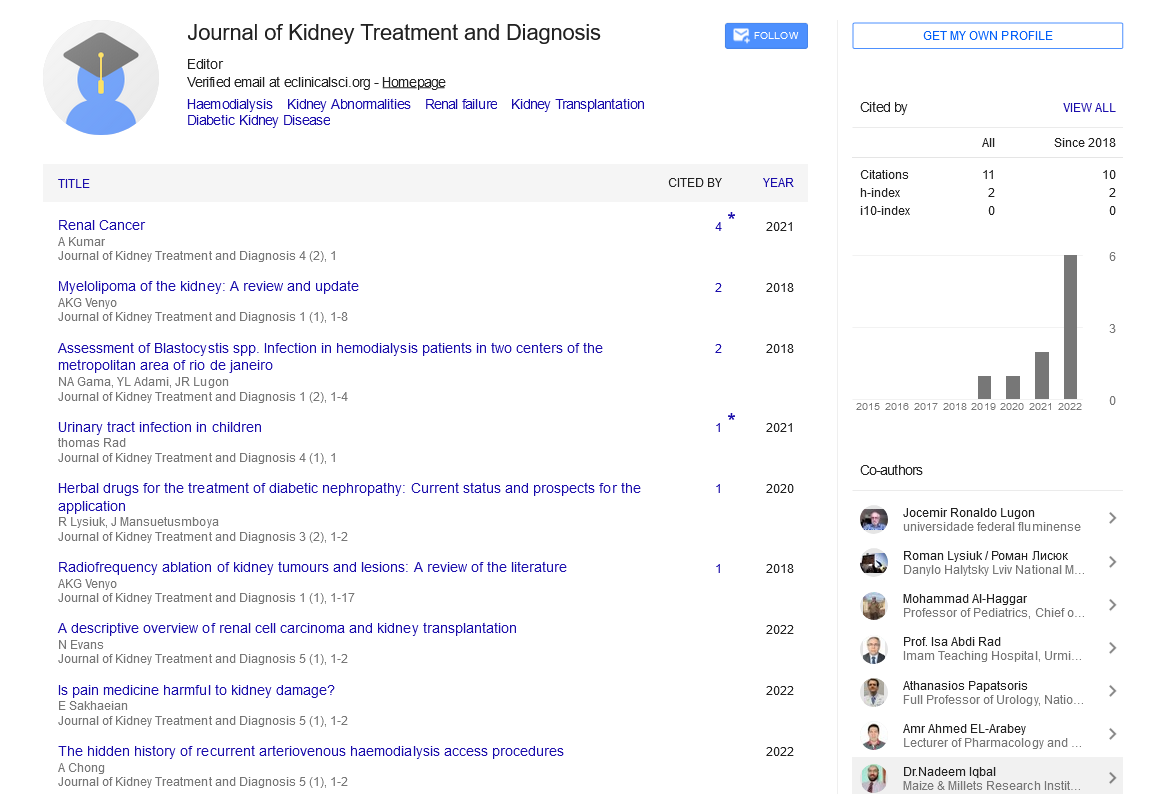Diagnosis of glomerular disease
Received: 01-Jan-2021 Accepted Date: Jan 15, 2021; Published: 22-Jan-2021
Citation: Naoh S. Diagnosis of glomerular disease. J Kidney Treat Diagn 2021; 4(1):4
This open-access article is distributed under the terms of the Creative Commons Attribution Non-Commercial License (CC BY-NC) (http://creativecommons.org/licenses/by-nc/4.0/), which permits reuse, distribution and reproduction of the article, provided that the original work is properly cited and the reuse is restricted to noncommercial purposes. For commercial reuse, contact reprints@pulsus.com
Description
Glomerular disease may be caused by an infection or a drug that is harmful to your kidneys. In other cases, it may be caused by a disease that affects the entire body, like diabetes or lupus. Many different diseases can cause swelling (inflammation) or scarring (sclerosis) of the glomerulus. A glomerular disease can be assumed to be present if the patient manifests glomerular hematuria, glomerular proteinuria, or both.
Glomerular disease harms the glomeruli, letting protein and at times red platelets spill into the urine. Now and then a glomerular infection likewise meddles with the freedom of byproducts by the kidney, so they start to develop in the blood. Besides, loss of blood proteins like egg whites in the pee can bring about a fall in their level in the circulation system. In typical blood, egg whites act like a wipe, bringing additional liquid from the body into the circulatory system, where it stays until the kidneys eliminate it. Yet, when egg whites spill in to the pee, the blood loses its ability to retain additional liquid from the body. The liquid can aggregate external the circulatory framework in the face, hands, feet, or lower legs and cause growth [1-2].
The essential glomerular infection influences the two kids and grown-ups cause about 10% of ESRD and expenses around 1% of Medicare dollars for RRTs. This analysis centers around a subset of the at present neurotically characterized essential provocative and non-inflammatory glomerular sicknesses, including Membranous Nephropathy (MN), negligible change infection (MCD), FSGS, and IgA Nephropathy (IgAN). Notwithstanding their significance, information on their pathogenic inceptions and viable treatments stay restricted. Patients with the glomerular infection have huge measures of protein in the pee, which might be alluded to as "nephritic range" if levels are extremely high. Red platelets in the pee are an incessant finding also, especially in certain types of glomerular sickness. Urinalysis gives data about kidney harm by demonstrating levels of protein and red platelets in the pee. Blood tests measure the degrees of byproducts, for example, creatinine and urea nitrogen to decide if the sifting limit of the kidneys is hindered. In the event that these lab tests show kidney harm, the specialist may prescribe an ultrasound or an x beam to see whether the shape or size of the kidneys is strange. A biopsy might be useful in affirming glomerular infection and recognizing the reason. Various illnesses can bring about glomerular infection. It could be the immediate aftereffect of contamination or a medication harmful to the kidneys, or it might result from an infection that influences the whole body, similar to diabetes or lupus. Various sorts of illnesses can cause expanding or scarring of the nephron or glomerulus. Now and again glomerular infection is idiopathic, implying that it happens without an obviously related illness. Glomerular hematuria is the aftereffect of disturbance of the glomerular filtration boundary (GFB) to the degree that red cells can go through the GFB. Glomerular proteinuria is the aftereffect of disturbance of the GFB to the degree that plasma proteins, which typically are generally rejected from the glomerular filtrate, can promptly go through the upset GFB. The most bountiful of the plasma proteins in egg whites. In this manner, the sign of glomerular proteinuria is albuminuria. In not many and explicit conditions, for example, youth steroid-touchy nephrotic disorder, analysis, and treatment are regularly managed without a kidney biopsy. In grown-ups, this methodology is remarkable yet might be considered in individual cases [3-5].
Conclusion
Glomerular hematuria is the result of disruption of the glomerular filtration barrier (GFB) to the extent that red cells are able to pass through the GFB. A biopsy may be helpful in confirming glomerular disease and identifying the cause. Sometimes glomerular disease is idiopathic, meaning that it occurs without an apparent associated disease.
REFERENCES
- Kohler H, Wandel E, Brunck B: Acanthocyturia - a characteristic marker for glomerular bleeding. Kidney Int 1991; 40:115-120.
- Jayne DR, Marshall PD, Jones SJ, et al. Autoantibodies to GBM and
- Malafronte P, Mastroianni-Kirsztajn G, Betônico GN, et al. Paulista Registry of glomerulonephritis: 5-year data report. Nephrol Dial Transplant. 2006;21:3098.
- Crew RJ, Radhakrishnan J, Appel G. Complications of the nephrotic syndrome and their treatment. Clin Nephrol. 2004; 62:245.
- Jayne DR, Marshall P, Jones S, et al. Autoantibodies to GBM and neutrophil cytoplasm in rapidly progressive glomerulonephritis. Kidney Int1990;37:965-70.





